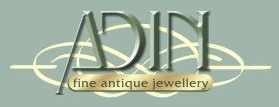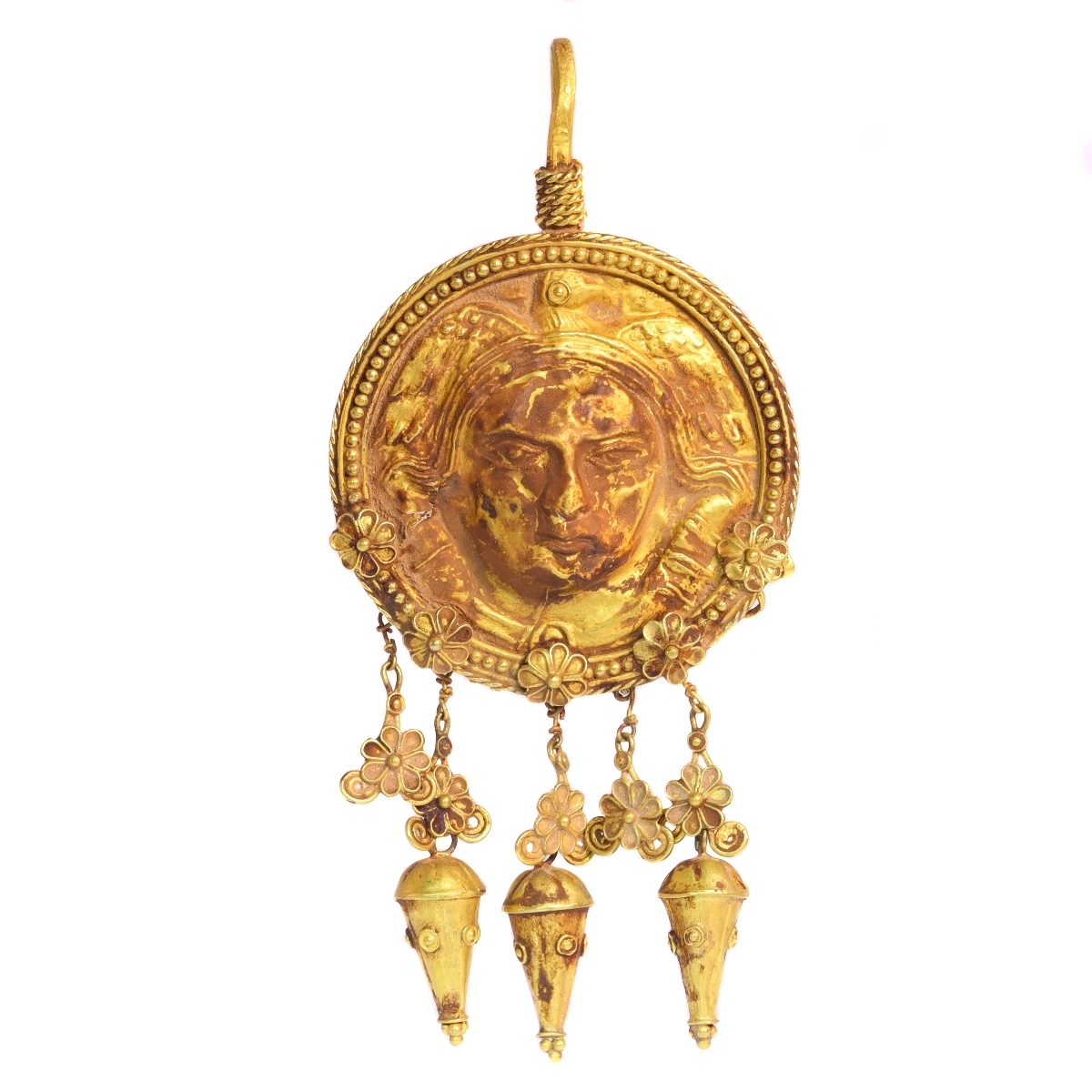We offer layaway, spread payments on the piece of your dreams. Ask us for details. Free insured shipping on all orders !!!
Ancient gold embossed portret of Zeus with eagle attribute as a symbol of ultimate power
To offer a genuine ancient artefact like this requires extra research. Therefore, we've gone through our library, through museum collections and auctions, before we could make any statements about this unique piece. Now, we're exhilarated to finally
share our findings with you.
Description
Considering the hooked earwire to the back, we can conclude that this historic artefact was meant to be part of a pair of earrings. From the earwire, a fine spiraled wire coils down to a sheet disk.
Another spiraled wire and an alignment of gold grains borders the disk's outer edge and frames a male's profile in repousse topped with an embossed bird that flanks the profile with its wings. The three-dimensionality of the chased image and the
expression on the face are superb, even more so when looked upon from the side.
On the bottom part of the filigree and granulated frame, there are five seven-petalled rosettes with a granule center attached. From each of the three bottom flowers, another coiled flower is suspended, leading up to an amphora pendant embellished with
granule centered ringlets and a pyramidal granule cluster tip. An extra coiled flower dangles on the side in between two of the cone pendants.
Dating and symbolism
Resemblance with Hellenistic art (400 BCE - 30 BCE)
Jewellery stemming from a gold disk with filigree and granulated ornaments and flowers are the signature design of Hellenistic jewellery art. This combination with a hammered portait makes it even more unique on the one hand, and even more specific to
date on the other hand.
The profile protruding from this disk is of none other than the Greek god Zeus, who we can identify thanks to Aetos Dios, which is the eagle that serves as the crown on his head in this portrait, as his unique attribute signifying the "all seeing"
characteristic of Zeus.
Based on other examples from the collection of the Met museum and the RISD museum, and on numerous auctions from Christies, we would state that this specific earring according to its style, craftsmanship and iconography originates from around 400 BCE.
Besides its period of origin, we've been debating whether this earring was meant to be a part of a pair or whether it could just as well be meant to stand on its own. When comparing to similar earrings from the Hellenistic era, we only came across pairs.
Furthermore, Hellenistic art is known for its symmetry from hairstyle to architecture. Therefore, we assume that this earring was originally part of a pair.
Another interesting fact about Hellenistic customs is that jewellery was used to be interchangeable between men and women. This earring could adorn a man just as well as a woman, or any gender for that matter.
Of course, we're very much open for any information from experts in this field.
Antique jewelry object group
This piece is most probably originally one earring of a pair. However, considering its age, it's not unusual that maybe the other one of the pair has gone missing.
Besides its original function of wear and besides its museological value, it can also beautifully serve as a pendant and for any gender.
Condition
Very good condition, especially considering that we can safely state that this piece dates from well before the common era.
More info on our condition scale
Country of origin
Ancient Greek Empire, which stretched from Greece through Egypt and the Persian empire to the Near East and India.
Style
Hellenistic
Period
ca. 400 BCE
Theme
Zeus is the king of all the gods in the ancient Greek culture. With the companionship of the eagle, we know that the disk portrays the profile of Zeus, which is meant to symbolise ultimate power.
Material
Not tested, but a high alloy of gold (18K+).
Technique
Granulation is a technique with which the goldsmith uses very small balls (granules) of metal, that are not soldered onto the jewel but welded. This technique demands very high skills and precision from the maker.
Filigree is a delicate kind of jewellery work with twisted wires, usually of gold or silver. These spiraled wires are often being soldered together to form an ornament or object.
Dimensions
Total length of the earring: ca. 11,00 cm (4,33 inches).
Diameter of disk: ca. 5,20 cm (2,05 inches).
See picture with a ruler in cm and inches
Weight
31,10 gram (20,00 dwt)
Adin Reference Nº
18020-0294
Copyright photography
Adin, fine antique jewellery
Sources
Other than the collections on Metmuseum.org, Risdmuseum.org and Christies.com, the book "Tiaras: A History of Splendour" by Geoffrey C. Munn also shows a similar piece on page 14. (ISBN: 978-1-85149-375-3)
Additional information
our latest acquisitions
jewelry glossary
wall of fame
visit us in Antwerp
subscribe to our mailinglist




